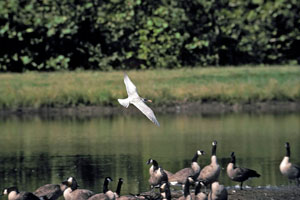
By Dan Zarlenga, Missouri Department of Conservation
Photo caption: A Caspian tern, a member of a worldly species, flies over a Missouri wetland. Photo courtesy the Missouri Department of Conservation.
During the month of September, Missouri skies see many avian visitors pass by on their autumn migration paths. There is one particular bird that is especially cosmopolitan. Even its name evokes a place exotic to most Midwesterners. Yet it graces the Show-Me-State with a brief stopover on its epic fall journey. It’s the Caspian tern.
Terns are a cohort of birds considered seabirds and they come from the same family as gulls. The Caspian is the largest of terns. It spreads a wingspan of over 50 inches. Adults have black legs, and a long and thick bill that’s prominently red-orange with a small black tip. Most of the bird is whitish, but breeding adults sport a dark black cap. They speak and a loud, harsh clack, much like the sound of a great blue heron.
Ornithologists did indeed name the bird for the Caspian Sea located east of the Caucasus between Europe and Asia, where it tends to be abundantly found. As a cosmopolitan bird though, the species can be also breed in large lakes and ocean coasts in North America, Europe, Asia, Africa, Australia, and New Zealand. The Caspian tern truly leaves its mark on many continents.
The Caspian terns in North America migrate through the continent (including over Missouri) to southern coasts, the West Indies, and the northernmost parts of South America. The birds fly at night during migration, and they sometimes stop at wetlands and large lakes in our state for rest or to grab a quick meal.
Caspian terns prefer to eat fish. The bird usually flies high over the water, then hovers until it catches sight of a prospective meal. Swiftly, it plummets to snatch a fish from below surface. Not being too proud, it may sometimes rob another bird of its food. Often in nature, ethics are dictated by practicality. Caspians will occasionally eat large insects too, or the young and eggs of other birds, and rodents.
Fish not only play an important role in the Caspian tern’s diet, but in its courtship as well. To get the interest of a female, a male Caspian flies over the colony carrying a fish. In time, it lands near a female of choice and presents the fish as a gift with a nodding gesture. If the female is receptive, it will take the fish. Sometimes the pair will perform a juvenile-like feeding display where they hunch down, jerk bills upward several times, and call. The newly minted pair will fly hundreds of feet into the air to perform courtship flights over the colony, loudly announcing their partnership.
Both partners participate in selecting a spot for their nest. They stake their own little piece of the world, usually a territory of five feet across, to raise their avian family. Once the eggs are laid, Caspian terns enthusiastically defend their small territories. They threaten would-be intruders by puffing up their feathers, raising their head crests, opening their bills, then making warning calls, and even attacking as a last resort. Their young are certainly well protected as they grow into the next generation of Caspian terns. All the world’s a stage for Caspian terns.
We are lucky enough that these amazing birds have some of their exits and their entrances within our small corner, just as we like it.


